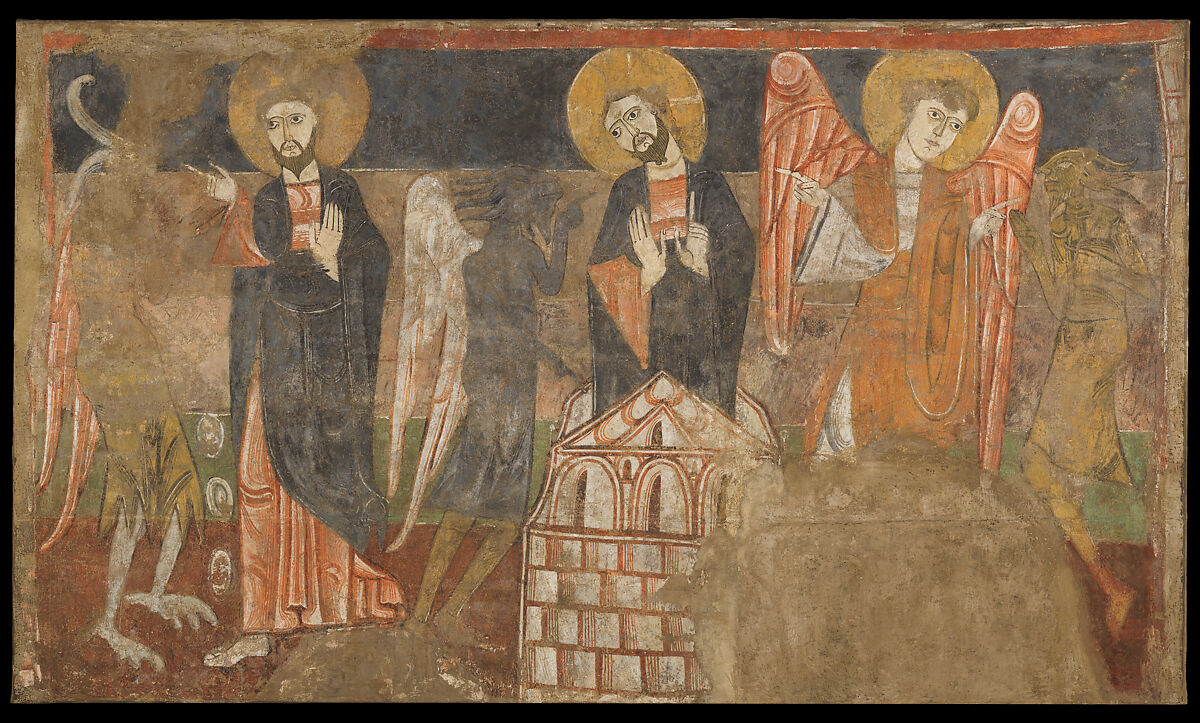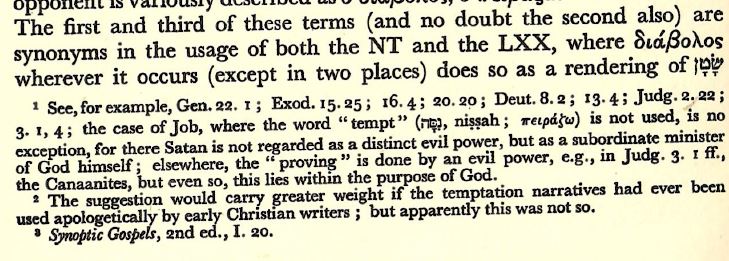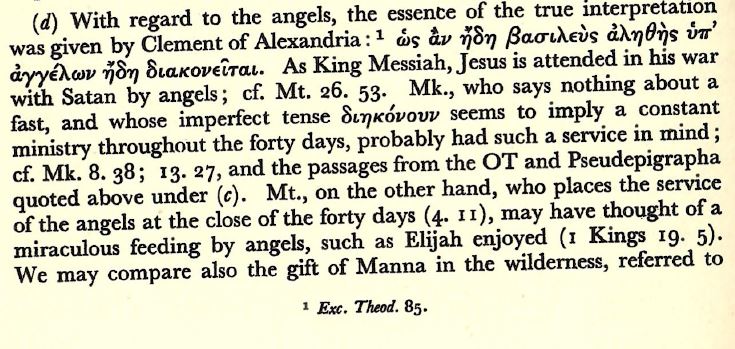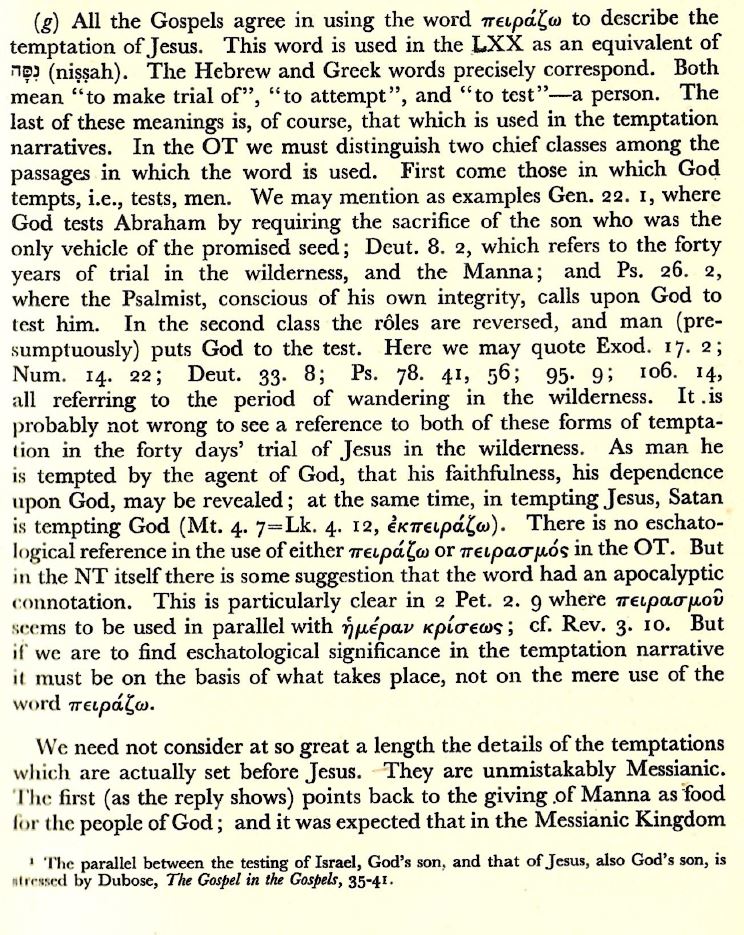1947
***
Chapter 4
Conflict with Evil Spirits – Temptation and Exorcism
(the section on Exorcism is not included)

Background
The temptation of Jesus involves Satan attempting to exploit Jesus’s vulnerabilities after fasting, challenging his divine mission. Satan’s aim is to derail Jesus’s role and authority as the Son of God (rejecting worldly power and physical needs to uphold his spiritual mission).
-
Turning stones into breadThe Devil tempted Jesus to use his power to satisfy his hunger. Jesus replied, “Human beings cannot live on bread alone, but need every word God speaks”.
-
Jumping from the templeThe Devil tempted Jesus to perform a sign of his sovereignty by throwing himself from the highest point of the temple. Jesus replied, “Do not put the Lord your God to the test”.
-
Taking the kingdoms of the worldThe Devil offered Jesus all the kingdoms of the world in exchange for worshipping him. Jesus replied, “Worship the Lord your God and serve only him!”.
WE have now considered the activity of the Spirit of God in the conception and at the baptism of Jesus. We have seen reason to believe that here the work of the Spirit has a profound theological significance, that is to say, it was regarded as an important factor in God’s dealing with the world, and one which had its place in the eschatological world-view; but the effects of the Spirit were not those commonly attributed to it and observable as activities of the human mind. This is plainly so with regard to the birth of Jesus; the new-born child cannot be called inspired.[I] It is true also in the baptism; for, as we have suggested, the baptism is to be thought of as the installation of the Messiah rather than as a prophetic calling and endowment. Now, however, as we proceed to consider the ministry of Jesus, psychological expressions of the possession of the Spirit come into view. In the primitive Church the gift of the Spirit was certainly accompanied by psychological ‘ activities expressed in speech or act, such as prophecy, glossolalia, and the other gifts described by St Paul.2 One might well expect it to be the same with Jesus; and so it was.
It might be said rather more accurately that in this section of the Gospel material, which deals with the conflict between Jesus and the powers of evil, the two categories of thought, theological and psychological, overlap, since the conflict is represented from both points of view. There is on the one hand the conflict between God and Satan, between the Kingdom of God and the power of Beelzebul; and on the other the manifest disorders of the human spirit ascribed in the time of Jesus to demon possession. In these two ways the tension of good and evil is expressed, in the one instance theologically, in the other psychologically; and both are taken up in the passages of the Gospels which fall now to be considered. The theological aspect of the conflict is stressed in the temptation narrative, the psychological in the exorcisms.
The Temptation: Mk. i. 12 f.; Mt. 4. 1-11; Lk. 4. 1-13. Cf. the Gospel according to the Hebrews in Origen, On John, 2. 12, and On Jeremiah, hom. 15. 4.
It appears that there are two narratives of the Temptation with which we have to deal, one given by Mark, the other contained in a source used by both Matthew and Luke. The Marcan account is much shorter than that which Mt. and Lk. have substantially in common, and it is sometimes held that what Mk. presents is merely an abbreviated version of that which is given by the other Evangelists in extenso. But this seems unlikely in view of the facts that (a) Mt. and Lk. both use the word ![]() (which in Hellenistic Greek need not be regarded as a strong and unsuitable word); (i) Mk. has no reference to the fasting and hunger which are an integral part of the narrative in Mt. and Lk.;[II] (c) Mk. does not use the term
(which in Hellenistic Greek need not be regarded as a strong and unsuitable word); (i) Mk. has no reference to the fasting and hunger which are an integral part of the narrative in Mt. and Lk.;[II] (c) Mk. does not use the term ![]() which occurs in the opening sentences of both Mt. and Lk.; {d) Mk. includes the two features of Christ’s being with the wild beasts and his being served by angels, the former of which is found in neither Mt. nor Lk., the latter in Mt. only.
which occurs in the opening sentences of both Mt. and Lk.; {d) Mk. includes the two features of Christ’s being with the wild beasts and his being served by angels, the former of which is found in neither Mt. nor Lk., the latter in Mt. only.
From these facts we ought to conclude2 that we possess two independent accounts of the Temptation, one given by Mk., the other belonging to the Q material; though Matthew may have taken from Mk. the ministry of the angels, and Luke, perhaps, the phrase ![]()
There is no difference in motive and meaning between the two temptation narratives, and it is particularly striking that both begin with a reference to the Holy Spirit; unless indeed this feature has been derived by Matthew and Luke from Mk. and not from their common source. In any case, Matthew and Luke must have thought such a reference not inconsistent with their non-Marcan material. We may begin by considering the longer and more explicit account, that of Mt. and Lk.
The temptations of Jesus have often been explained as due to a natural mental reaction to the events of the preceding narrative of the baptism. So (to choose one example out of many) Plummer 3 says: “It is the common experience of mankind that times of special spiritual endowment or exaltation are followed by occasions of special temptation. The Messiah is no exception. No sooner is He anointed with the Spirit for the work of the Ministry than He has to undergo a fierce conflict with the great personal power of evil.” In the Q, narrative there is some apparent justification for this view, for the several temptations are described in pictorial-psychological form.
By other scholars 4 the temptations are regarded as similar to those ascribed in other religious literature to other holy men. Thus Abraham is tempted (Gen. 22. 1); Buddha is tempted by Mara.® The motive for the inclusion of the temptation narrative in the Gospel tradition would then become that of the example story; the Christians are to resist and overcome temptation as did the Lord (and in the same way—by the use of Scripture, Jas. 4. 7; 1 Pet. 5. 9). Another motive which should not be ignored is that of apologetic. The Church had to face such questions as, Why was the alleged Messiah poor and in physical need? Why did he not afford unmistakable signs of his power and authority? Why did he not unite his nation for the purpose of world conquest? To these questions the temptation narrative supplies convenient answers.
- With Streeter, Four Gospels, 187 f.
- g.. Bultmann, GST 270 ff.
Nevertheless, we have not yet arrived at a sufficient understanding of the temptations as they stand in the Synoptic tradition. To regard the temptations as mental reaction from a spiritual illumination, a trough of doubt and despondency following a crest of certainty, is a quite inadequate view of the Evangelists’ intention. They were not novelists of the psychological school, and they very rarely or never pause to depict the inner mind of Jesus and to discuss his feelings. Besides, the more strongly we hold the baptism to be an event used by the Evangelists to explain the person of Jesus, that is, for a theological purpose, rather than a zenith of religious experience, the less justification is there for regarding the temptations as the corresponding nadir. Again, it seems improbable that the temptations were recorded simply as moral paraenesis. They are not well adapted to this end. Early Christian ethical instruction was usually quite pointedly applied to the particular situations to which it was directed; and, though some of the believers may, as has been suggested, have been inclined to overestimate the importance of the miraculous, it is unlikely that they were tempted to turn stones into bread or to fly down from a pinnacle of the Temple. In the OT, moreover (and this, rather than Buddhist literature, is decisive for NT interpretation) the righteous, or the people of God, are tested not by any of the powers of evil, but by God himself.1 The suggestion that the temptation narratives have an apologetic motive is more cogent, and may possibly represent part of the truth; 2 but it hardly supplies a complete motivation, and leaves unexplained the most characteristic features of the narratives.
The true interpretation of the temptations is succinctly expressed by ‘ Montefiore:8 “Both in Mk. and in Q, the temptation is ‘Messianic,’ i.e., it is the temptation of the Messiah, not of an ordinary individual.” The psychological form of the narrative is only superficial, and is the medium of a myth, in its essentials not uncommon in religion, which deals with a battle among divine beings for dominion over the world. The victorious protagonist is the newly appointed Messiah. It is he who is attacked by Satan as no other could be; he only could be tempted to establish himself over against God as an independent divine being. His opponent is variously described as 6 Bcd^oXos, 6 ireipatfitv and 6 Saravas.

(satan). There is no need to trace in detail the history of this word, or to decide whether its accepted derivation and meaning, “accuser”, is or is not to be preferred to the etymology given by Dr Torczyner,[3] who explains it as originally the roving eye of God, i.e., his travelling police officer who reports on the political loyalty of his subjects.[4] It is sufficient to remark that in the beginning the Satan was a member of the heavenly court, i.e., a spiritual being, and that in course of time his office developed from public prosecutor to public enemy. Under various names (Beliar, Sammael, Mastema) a Satan, or prince of evil, appears in later Jewish literature as an opponent of God, or as an Antichrist.[5]
If it be true (and further evidence will be brought to show that it is) that the Q temptations are essentially Messianic, the same is a fortiori true of the Marcan temptation, which has no psychological or ethical motivation. Wellhausen indeed said:1 “The temptation of Jesus has in Q a definitely Messianic character. … In Mk. the temptation at this place (1. 12, 13) is not Messianic. The Messianic temptation, according to Mk., does not come after the baptism, but only after the confession of Peter.” But, though there is an important parallel between the Q, temptation and Mk. 8. 32 f., this position cannot be maintained; if the Marcan temptation be not Messianic it is impossible to understand it at all. [6]
We may turn next to examine the details of the two temptation narratives, with regard first to their setting, then to the temptations themselves (in Q).

simply to emphasize the loneliness of the place; the struggle took place in the complete absence of human beings, attended only by brutes. Cf. Is. 13. 21; 2 Macc. 5. 27. (3) Dominion over the beasts is sometimes (see the passages cited below) associated with conquest over Satan; this may be the case here. The Messianic prophecies in Is. 11. 6; Ezek. 34. 25 are important here, and we should also compare Ps. 91. 11-13 and Job 5. 23. In all these passages the wild beasts have, in different ways, ceased to be dangerous. In the Testaments of the XII Patriarchs, which seem to have influenced the NT so widely, we find side by side the discomfiture of evil spirits and the submission of the animals.
Test. Issach. 7. 7 :
Every spirit of Beliar shall flee from you, And no deed of wicked men shall rule over you; And every wild beast shall ye subdue.
Test. Benj. 5. 2 :
If ye do well, even the unclean spirits will flee from you, and the beasts will dread you.
But we may note especially Test. Napht. 8. 4 :
If ye work that which is good, my children, Both men and angels shall bless you;
And God shall be glorified among the Gentiles through you, And the devil shall flee from you, [cf. Jas. 4. 7] And the wild beasts shall fear you, And the Lord shall love you,
And the angels shall cleave to you.
The last line is omitted by Charles for reasons of parallelism; but the association of angels, beasts and the devil is very striking; cf.Ps.91. 11-13.
There is no reason why (1) and (3) should not be combined in the exegesis of this reference to the wild beasts. It is precisely as the Second Adam, the Heavenly Man, that Jesus effects the eschatological conquest over Satan, which results in a salvation that means the restoration of primeval bliss. This interpretation is attractive, but it would be dangerous to pronounce definitely in favour of it against (2).

in Ps. 78. 25 as the food of angels (D’TSK, ‘abbirim). The angels are the counterpart of the wilderness-demons.
(e) Jesus (according to Mt. and Lk.) fasts during the temptations. The detail is probably added as a motivation for the first temptation; it may also have been intended to recall the fasts of Moses (Exod. 34. 28; Deut. 9. 9) and of Elijah (I- Kings 19. 8).
(f) The period of forty days (in any case, a biblical round number) is probably a further reference to the fasts just mentioned, which also lasted forty days. A parallel may be intended also with the forty years of temptation which Israel underwent in the wilderness.[8]

the supply of Manna would be renewed.1 To explain the second temptation (Matthaean order) another tradition has been noted, that “When the King Messiah reveals himself, he comes and stands on the roof of the Temple”.2 But there is no need to suppose that the Gospel depends upon this tradition. The temptation is simply to perform a compulsive sign, to put the fact of the Messiahship beyond all possible doubt. The third temptation (Matthaean order) is also peculiarly Messianic. The high mountain is neither “a visionary conception as Rev. 21. 10; Apoc. Bar. 76. 3”, nor “an originally mythical mountain of the gods”, nor a “fairy-tale motif”.3 It is Pisgah, the mountain whence Moses viewed the promised land. So from this mountain Jesus has in prospect a possible kingdom* which he rejects: the Messianic Kingdom was not to be acquired by submission to Satan.
The temptations are all answered by Jesus (and one of them is addressed to him) in terms of Scripture. The conversation between Jesus and the devil reads almost like a Rabbinic controversy, in which the missiles are proof texts. It is true that the Torah was thought of as in some sense a weapon against the angel of death,8 but the form of the temptation narrative is certainly much more akin to a debate in the Schools than to a war of gods and spirits.
The temptation narratives are indeed compounded of very diverse elements. Their basis is mythical; it is the old story of a war of the gods, adapted to a particular Messianic conflict. The devil is defeated, but he is not destroyed. The Church was too well acquainted with his devices to suppose that Satan had died. The Messianic Kingdom had an activity neither unrestricted nor unopposed. The mythical, Messianic basis of the narratives is treated in a psychological manner. Jesus faces the devil under the inspiration of the Spirit, which leads him to the conflict, thus transferred from the world of the gods to the field of the mind. The ancient saga (which appears in various forms) of a battle between God (or the gods) and the devil, and the account of an inward experience of the human mind, are both pictorial, and inadequate, means of setting forth the conflict between good and evil which was brought to a crisis in the ministry of Jesus. In the conflict itself he appears in the role which we know he filled, that of a teacher, arguing from Scripture. The outcome of the struggle, which clearly points toward the exorcism narratives which we shalkjshortly consider, is what may conveniently be described as the Messianic secret. He who from the time of the baptism is Messiah cannot by any outward sign declare his title, or enter forcibly upon his Kingdom. This is apparently the force of his refusal to work compulsive Messianic signs. Hence, as we shall see, he commands the demons to be silent, and keeps his cures secret. From this point, with the exception of one or two instances, we hear no more of Jesus acting in, or under the influence of, the Spirit. He is a hidden Messiah, not repealed by specifically Messianic works or an evidently Messianic endowment of the Spirit.
- We need not distinguish between the two views which were held : (i) fresh supplies of Manna were prepared in the third heaven : 12b, 2 Baruch 29. 8 ; (ii) the golden pot of Manna, which, with the ark, had disappeared, was to be restored : Tanh 83b, et al.
- P’siq. R. 36 (162a) ; Str.-B. I. 151. • Klostermann, Matthausevangelium, 29.
- All the kingdoms of the earth ; cf. Rev. 11. 15. • Str.-B. I. 149.
The Exorcisms (not included)
The temptation of Jesus appears differently across the Gospels, primarily found in Matthew, Mark, and Luke, while John omits it. Here’s an overview comparing the accounts in each:
1. Mark (1:12-13)
Mark provides the briefest account:
- The Spirit drives Jesus into the wilderness immediately after his baptism.
- Jesus is “tempted by Satan” for forty days, and he is “with the wild animals,” but no specific temptations are described.
- Angels attend to him, highlighting a sense of divine support.
Mark’s account emphasizes Jesus’s encounter with Satan and the wild, untamed nature of the setting, suggesting both confrontation and protection, but it omits specific temptations and conversations.
2. Matthew (4:1-11)
Matthew offers a detailed narrative with three specific temptations:
- First Temptation: Satan challenges Jesus to turn stones into bread, appealing to his hunger after fasting. Jesus responds with scripture, asserting, “Man shall not live on bread alone” (Deuteronomy 8:3).
- Second Temptation: Satan takes Jesus to the pinnacle of the temple, urging him to throw himself down to prove his divine protection, quoting Psalm 91. Jesus counters, “You shall not put the Lord your God to the test” (Deuteronomy 6:16).
- Third Temptation: Satan shows Jesus all the kingdoms of the world, offering them in exchange for worship. Jesus rebukes him with, “You shall worship the Lord your God and serve him only” (Deuteronomy 6:13).
Matthew’s account emphasizes Jesus’s role as a fulfillment of Israel’s history, using scripture to counter each temptation and depicting a strong sense of mission.
3. Luke (4:1-13)
Luke’s version closely mirrors Matthew’s but with one key difference in the order of temptations:
- The second and third temptations are switched: Luke places the temptation of worldly power (kingdoms) second and the temple pinnacle test last. This shift emphasizes a progression from physical needs to authority and, finally, to Jesus’s identity and trust in God.
- Luke also ends with Satan departing “until an opportune time,” suggesting future confrontations (hinting at continued temptation throughout Jesus’s ministry).
Luke’s order and closing statement underscore Jesus’s resistance to both worldly and spiritual challenges, framing the temptation as an ongoing struggle.
4. John
- The Gospel of John does not include an explicit temptation narrative. Instead, Jesus’s divine identity and authority are expressed through signs and discourses, including the calling of disciples and the miracle at Cana. This absence suggests John’s focus on Jesus’s divine mission without the wilderness testing.
Comparison Summary
- Mark highlights the setting and the starkness of Jesus’s isolation and divine support but omits details.
- Matthew presents the temptations as a test of Jesus’s role as the new Israel, resisting Satan by citing scripture and emphasizing his identity as the obedient Son.
- Luke focuses on the continuous nature of temptation, adjusting the order to emphasize spiritual testing.
- John omits the temptation, focusing instead on Jesus’s divine authority and mission directly through signs and teachings.
Each account reflects different theological emphases: Mark’s brevity highlights mystery, Matthew’s structure emphasizes fulfillment, Luke’s order implies a narrative of ongoing resistance, and John’s omission signals an emphasis on divine identity over earthly trials.